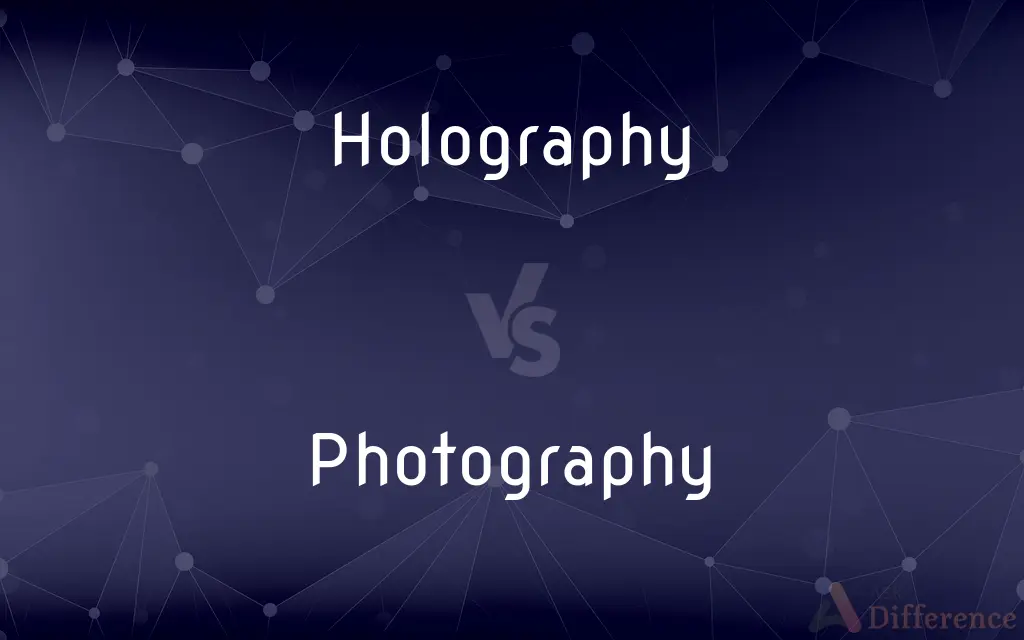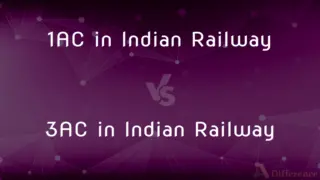Holography vs. Photography — What's the Difference?
By Tayyaba Rehman & Fiza Rafique — Published on February 5, 2024
Holography is a technique of capturing light fields to create three-dimensional images, while photography captures two-dimensional images through light exposure on a medium.

Difference Between Holography and Photography
Table of Contents
ADVERTISEMENT
Key Differences
Holography records both light intensity and phase to create three-dimensional images, offering a more realistic depiction of the subject. Photography, in contrast, captures only the light intensity, resulting in two-dimensional images that represent the visual appearance of a subject.
The process of holography involves the use of laser light to record detailed information of a subject, including depth information. Photography, however, utilizes natural or artificial light to capture the likeness of a subject on light-sensitive surfaces like film or digital sensors.
Holographic images can be viewed from different angles, providing a sense of depth and realism, akin to looking at the actual object. Photographic images are static and flat, offering only a single perspective of the subject as captured by the camera lens.
The technology behind holography is more complex, requiring specific conditions like coherent light sources and stability during recording. Photography is more accessible and user-friendly, with a wide range of devices available for various skill levels and purposes.
Holography is often used in scientific and technical fields for its ability to provide detailed three-dimensional representations. Photography is ubiquitous, used in everything from personal memory keeping to professional art and media.
ADVERTISEMENT
Comparison Chart
Dimensionality
Creates three-dimensional images
Captures two-dimensional images
Light Recording
Records light intensity and phase
Records only light intensity
Viewing Perspective
Can be viewed from multiple angles
Offers a single perspective
Technological Complexity
Requires coherent light and stability
Accessible with a variety of equipment
Common Usage
Used in scientific, technical fields
Widespread in personal, professional use
Compare with Definitions
Holography
A technique for creating three-dimensional images using light interference.
Holography was used to create a detailed 3D image of the ancient artifact for study.
Photography
An art form focused on producing images by recording light patterns.
Black and white photography emphasizes textures and contrasts in the composition.
Holography
The process of recording and reconstructing the light field of a scene.
The holography exhibit displayed lifelike images that seemed to pop out of the frame.
Photography
A technique of capturing visual images by exposing light-sensitive material.
Photography classes often begin with understanding how to manipulate light and shadow.
Holography
An advanced imaging technique capturing a full light field.
In a medical setting, holography provides detailed views of internal organs.
Photography
The art or process of creating images by recording light on a sensitive medium.
Her passion for photography led her to travel the world capturing breathtaking landscapes.
Holography
The art of creating holograms for three-dimensional visualization.
Holography is being explored in modern art installations for immersive experiences.
Photography
The process of creating still images by capturing light on film or a digital sensor.
In the era of digital photography, editing and sharing photos have become instant.
Holography
A method to display images in three dimensions using laser light.
Holography technology is revolutionizing the way we experience virtual reality.
Photography
The art or process of producing images of objects on photosensitive surfaces.
Holography
A method of producing a three-dimensional image of an object on a photographic plate or film by recording on it the interference pattern formed by a split laser beam, one beam of which illuminates the object while the other does not. Illuminating the pattern either with a laser or with ordinary light produces the image.
Photography
The art, practice, or occupation of taking and printing photographs.
Holography
(physics) a technique for recording, and then reconstructing, the amplitude and phase distributions of a coherent wave disturbance; used to produce three-dimensional images or holograms
Photography
A body of photographs.
Holography
The process of producing holograms, usually requiring a source of coherent light, as from a laser.
Photography
The art and technology of producing images on photosensitive surfaces, and its digital counterpart.
Go on a photography course
Holography
The branch of optics that deals with the use of coherent light from a laser in order to make a hologram that can then be used to create a three-dimensional image
Photography
The occupation of taking (and often printing) photographs.
Photography
The science which relates to the action of light on sensitive bodies in the production of pictures, the fixation of images, and the like.
Photography
The art or process of producing pictures by this action of light.
Photography
The act of taking and printing photographs
Photography
The process of producing images of objects on photosensitive surfaces
Photography
The occupation of taking and printing photographs or making movies
Photography
The practice of creating durable images by capturing photons.
Drone photography has opened up new perspectives in capturing landscapes.
Common Curiosities
Can photography capture depth like holography?
Traditional photography captures images in two dimensions, lacking the depth perception offered by holography.
How does photography work?
Photography involves capturing images by exposing a light-sensitive medium, like film or a digital sensor, to light.
How is a hologram created?
Holograms are made by splitting laser light into two beams, one reflecting off an object and the other serving as a reference beam, which then interfere to create the holographic image.
Can holograms be viewed without special equipment?
Typically, holograms require laser light or other coherent light sources and special equipment for viewing, such as a holographic plate or display.
What is holography?
Holography is a technique for creating three-dimensional images using laser light and recording light fields.
What makes holographic images unique?
Holographic images are unique in their ability to display scenes in three dimensions, offering multiple perspectives.
Are special tools required for holography?
Yes, holography requires specific tools like lasers and stable recording environments.
What is a common use of photography?
Photography is commonly used for artistic expression, documentation, and personal memory keeping.
What are the main components of a camera?
A camera consists of a lens to focus light, a shutter to control exposure, and a sensor or film to capture the image.
Are holograms used in entertainment and art?
Yes, holography is used for creating captivating art installations and holographic performances, offering unique visual experiences.
What is the difference between a photograph and a snapshot?
A photograph is a carefully composed and captured image, while a snapshot is usually a quick, candid, and less planned photograph.
Is photography considered an art form?
Yes, photography is widely recognized as both an art form and a means of visual storytelling.
Can photography be used for scientific purposes?
Absolutely, photography plays a crucial role in scientific research, documenting experiments, and capturing phenomena that aid in understanding the natural world.
What are some popular genres of photography?
Popular photography genres include portrait, landscape, wildlife, macro, street, and fashion photography, among others.
Share Your Discovery

Previous Comparison
1AC in Indian Railway vs. 3AC in Indian Railway
Next Comparison
Windows 7 Home Premium vs. Windows 7 UltimateAuthor Spotlight
Written by
Tayyaba RehmanTayyaba Rehman is a distinguished writer, currently serving as a primary contributor to askdifference.com. As a researcher in semantics and etymology, Tayyaba's passion for the complexity of languages and their distinctions has found a perfect home on the platform. Tayyaba delves into the intricacies of language, distinguishing between commonly confused words and phrases, thereby providing clarity for readers worldwide.
Co-written by
Fiza RafiqueFiza Rafique is a skilled content writer at AskDifference.com, where she meticulously refines and enhances written pieces. Drawing from her vast editorial expertise, Fiza ensures clarity, accuracy, and precision in every article. Passionate about language, she continually seeks to elevate the quality of content for readers worldwide.
















































